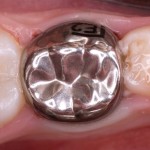
Stainless steel crowns (SSCs) are recommended for extensive decay anterior and posterior primary teeth. While reviews have demonstrated their superior effectiveness over conventional restorations they fail to satisfy parental concerns about aesthetics, particular when used to restore anterior teeth.
A range of more aesthetic option are available and the aim of this review was to evaluate the clinical effectiveness of all types of aesthetic preformed crowns for restoring primary teeth compared with conventional filling materials or other types of crowns.
Methods
Searches were conducted in the Medline Cochrane Central, clinical trials.gov and the World Health Organization International Clinical Trials Registry databases. Randomised controlled trials comparing aesthetic preformed crowns (resin composite strip crowns, open-face SSCs, pre-veneered SSCs, zircon crowns) with conventional filling materials, SSCs, or different aesthetic preformed crowns for restoring primary teeth were considered. Two reviewers independently abstracted data and assessed study quality using the Cochrane risk of bias tool. A narrative summary of the findings was presented.
Results
- 7 studies were included.
- 1 study considered primary incisors the remainder molar teeth.
- Follow-up periods ranged from 1-4 years.
- The risk of bias was considered to be high for all 7 studies.
- For primary molars the overall high risk of bias of the included RCTs does not permit aesthetic crowns (pre-veneered or open-face stainless steel crowns) to be recommended as replacements for SSCs.
- For primary incisors a single study confirmed poorer success of resin composite strip crowns favouring zircon crowns regarding both restoration failure and gingival health
Conclusions
The authors concluded: –
The majority of the included RCTs involved primary molars. Because of the risk of bias, changing the recommendations for posterior teeth is not advised. Regarding restoration failures of the commercialised preformed paediatric crowns, zircon crowns appeared as the best on incisors for a follow-up of only 6 months. Zircon crowns should be evaluated over periods of at least 1 year in primary anterior and posterior teeth.
Comments
The 2015 Cochrane review by Innes et al (Dental Elf -6thJan 2016) looked at all RCT studies of preformed crowns for decayed primary molar teeth and only included one of the 7 studies included in this review. As the authors of this new review note note the all studies were all at high risk of bias and they were also small and likely to have been underpowered. At present the SSC remains the most effective for posterior primary molars and restoration of primary anterior teeth remains clinically challenge due to their small size close proximity of the pulp to, relatively thin enamel, and lack of surface area for bonding, emphasizing the need for effective caries prevention for an early age.
Links
Primary paper
Aiem E, Smaïl-Faugeron V, Muller-Bolla M. Aesthetic preformed paediatric crowns: systematic review. Int J Paediatr Dent. 2016 Aug 17. doi: 10.1111/ipd.12260. [Epub ahead of print] PubMed PMID: 27532506.
Other references
Dental Elf -6thJan 2016
Crowns more effective than fillings for decay in primary molar teeth

Preformed paediatric crowns: little evidence for aesthetic crowns https://t.co/RmAqjfHC5l
Preformed paediatric crowns: little evidence for aesthetic crowns https://t.co/CLFav1NJUW
Little evidence on effectiveness of preformed paediatric aesthetic crowns https://t.co/CLFav1NJUW
Evidence is lacking for the use of preformed paediatric aesthetic crowns https://t.co/CLFav1NJUW
Effectiveness of preformed paediatric aesthetic crowns: little evidence available https://t.co/CLFav1NJUW
Don’t miss- Preformed paediatric crowns: little evidence for aesthetic crowns https://t.co/CLFav1NJUW